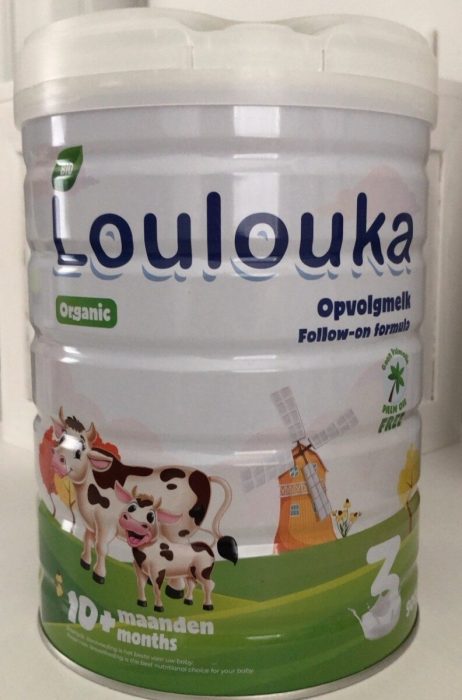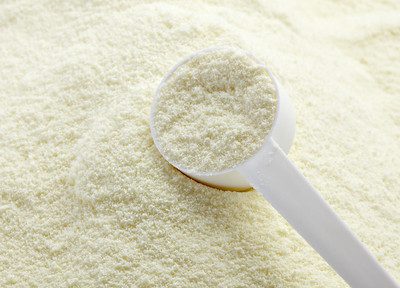What is Loulouka? What are the benefits it offers?
It is a highly regarded organic infant milk that provides nourishment and essential nutrients for growing kids. Developed by a group of milk manufacturers with over ten years of expertise, The product was made by parents for parents.

Loulouka was built from Swiss milk resources. They replaced soy and palm oil with coconut oil. Why?
- Because coconut oil is reported to be a more sustainable substitute than the former.
- Many studies have proven that coconut oil supports the proper development of the baby. By switching to conventional coconut oil instead of palm oil, the brand took a significant stride.
- Coconut oil supports the proper growth of the baby by enhancing the absorption of essential nutrients from milk.
- Now, Loulouka is made from coconut oil, rapeseed oil, and sunflower oil. This supports environmental sustainability.
- Additionally, the Loulouka milk formula also has a DHA formulation derived from refined fish oil, which is loaded with Omega-3 fatty acids.
The brand follows controlled organic production guidelines and the entire production process is strict and complex. Consult your child’s pediatrician before switching from breast milk to follow-on milk at all times, as some kids may not be tolerant to coconut oil. Here are more things you need to know about this wonderful popular brand.
- Loulouka is a Swiss-made formula created with all the necessary components and locally sourced organic cow’s milk for the needs of your baby.
- Essential vitamins, fats, and minerals necessary for promoting proper growth in infants are thoughtfully incorporated. It contains folic acid, sodium chloride, magnesium chloride, calcium citrate, potassium chloride, potassium hydroxide, calcium chloride, calcium phosphate, sunflower lecithin, zinc sulfate, potassium iodate, iron sulfate, copper sulfate, sodium selenate, tocopherol-rich extract, and other essential nutrients needed to promote proper growth of babies.
- Baby Formula of Loulouka contains choline bitartrate, zinc sulfate, sodium citrate, and iron sulfate, all of which are essential for the well-being of growing babies. These specific vitamins and minerals are carefully incorporated to support the cognitive development, immune system, and overall health of your baby.
One Of The Best Organic (Bio) Formulas
Stage 1 never compromises on quality (from birth to 6 months). They go above and beyond the most recent EU recommendations for baby formula by including DHA, ALA, and LA in addition to prebiotics, inositol, choline, and amino acids.

Milk Formula Ingredients
- The components of the Loulouka formula are cutting-edge, going above and beyond standards to contain Omegas, prebiotics, amino acids, inositol, and choline.
- All stages of Loulouka utilize skim milk rather than whole milk, which has been proven to be more tolerated by infants and newborns. Whole milk contains more calories. More importantly, whole milk contains more saturated fat compared to skim milk.
- The quality of Loulouka’s newborn milk will benefit in some relatively intangible ways from using Swiss organic milk products. These advantages contain minimal amounts of pesticides, herbicides, antibiotics, and toxic metals yet are not listed on an ingredients label.
- Importantly, the formula does not have starch or soy. EU organic certified, Loulouka reinforced its commitment to offering a wholesome and balanced choice in baby nutrition.
Stage 1 Vs Stage 2 Formula
The brand is certified as EU organic, guaranteeing that it meets stringent organic standards. This certification ensures that it is produced using organic farming practices and is free from harmful chemicals or additives. Parents who choose this milk product can have peace of mind knowing they are providing their little ones with high-quality, organic baby milk that is both nutritious and safe.
Stage 1 is meant to be used from birth, and Stage 2 is intended for use after six months.
- In Loulouka Stage 1, lactose is the primary source of carbohydrates (similar to breastfeeding), whereas maltodextrin is added in Stage 2. Maltodextrin is not the best carbohydrate to employ. Therefore, when it is, we prefer to combine it with lactose, as we do in Stage 3. Of course, keep in mind that each serving of Loulouka Stage 2 contains 5.3g more lactose than maltodextrin (2.4g).
- Loulouka Stage 1 is a comprehensive blend of essential minerals and vitamins crucial to fostering your child’s strength and well-being. It includes key nutrients like iron, vitamins A, C, and D. Notably, Vitamin D is essential to absorb calcium and support bone health.
- One notable ingredient found in Loulouka Stage 1 is manganese sulfate, which plays a crucial role in various bodily functions such as calcium absorption and metabolism. This mineral contributes to the overall growth and development of infants.
- Loulouka Stage 1 Organic (Bio) supports bottle feeding and promotes healthy development. It is known because of its use of high-quality raw materials, including skimmed milk and vegetable oil, ensuring an infant’s optimal nutrition. It does not use sweeteners colors or preservatives, emphasizing a commitment to providing a pure and natural option.
- Moreover, Inositol and several other amino acids present in the Loulouka Stage 1 formula are eliminated in the Loulouka Stage 2 formula. (L-tryptophan, L-cysteine, L-carnitine).
Stage 2 Versus Stage 3
The critical distinctions between Loulouka Stages 2 and 3 are two.
- First, the Stage 3 formula returns a very small amount of lactose to the list of ingredients. Additionally, it eliminates the last amino acid from Stage 2. (L-tyrosine).
- Stage 3 formula is meant to be consumed by infants aged 10+ months, while Stage 2 is intended for kids aged 6+ months.
Palm oil, food starch, corn syrup, corn syrup solids, artificial colors, flavors, preservatives, sucrose, soy, genetically modified organisms (GMOs), carrageenan, or high fructose corn syrup are some of the ingredients that are not included in any of the stages of Loulouka Infant Milk. Palm oil was substituted with coconut oil. The latter has more capacity to help in preventing heart disease and increase good cholesterol.

Nutritional Contents
The daily intake is suggested by Loulouka in their “Feeding Guide” because the USDA standards are for daily intake. Stage 1 recommends consuming approximately 110 grams daily within the first six months; naturally, this amount is lower in the first month (about 85 grams) and rises to over 130 grams/day with age.
We calculated an estimate of the daily nutritional intake an infant consumes using the typical serving size for the first six months. Naturally, this will overestimate nutrients in the early months, whereas, in later months, it will underestimate them. However, our analysis will show that there isn’t much cause for fear.
In general, Loulouka exceeds USDA dietary requirements. Infant formula sold in Europe often has a little less fat than recommended by the USDA. Notably, compared to American infant milk, European milk often contains somewhat higher protein and slightly lower fat content. Omega-6 is also somewhat below the required levels, while HiPP and Holle Stage 1 satisfy this criterion.
The USDA recommends 31g of fat per day, which is precisely the same amount of fat found in breast milk (about 4.2g per 100 mL, or 30.8g per 100g). Loulouka has a daily intake of around 28g, comparable to both HiPP Combiotic and Holle Stage 1. In general, EU infant formulas favor proteins and carbohydrates in Stage 1, followed by proteins and fats in Stage 2.
It exceeds the USDA’s guidelines for protein and fat for Stage 2 but falls just short of their recommendation for carbohydrates. In other words, the Stage 2 recipe is moving away from a high-sugar diet and toward one higher in protein and fat.
The USDA changes the relative quantity of carbohydrates, proteins, and lipids from 0 to 6 months to 6 to 12 months. As infants transition from Stage 1 to Stage 2, there is a divergence between European and American feeding guidelines, with proportions moving in opposite directions. It is significant to note that it is acceptable to mix infant milk with infant food to make up for other nutrients that may be needed when the child turns six months old.

Conclusion
As European formulas are imported to the US and utilized by American parents, we think it’s terrific to see greater competition, especially when the new formulas are high-quality.
All in all, it is a great choice for infants, promoting proper growth and development. The careful selection of raw materials, inclusion of essential nutrients, and EU organic certified badge make it a reliable option for parents seeking a safe and nutritious brand for baby food. The brand’s commitment to quality and organic standards sets it apart from other brands in the market, making it a popular choice among health-conscious parents looking to provide the best for their babies.
Loulouka organic Swiss milk, whey, and lactose are excellent. We enjoy that they include Omega 3 and Omega 6 fatty acids in their milk formulas (only Omega 3 in DHA form is required in the EU), prebiotics, choline, inositol, and essential and non-essential amino acids.
The brand has detailed nutritional labeling, including lactose and carbohydrate quantities. Stage 1 has 7 g of lactose per meal, just like breast milk. In Stages 2 (5.3g lactose per serving) and 3, maltodextrin is still used (5.1g lactose per serving).
Like all European baby formulas, Loulouka’s nutritional profile was a little low on fat content (coconut oil has less fat compared to palm oil) and emphasized protein and carbs in Stage 1. However, compared to US recommendations, all other macronutrients (carbohydrates, proteins) and micronutrients (vitamins, minerals) were at excellent levels.
Loulouka’s milk was unexpectedly similar to breastmilk in terms of blending, flavor, and acceptance. Its overall acceptance rates were very high.
All baby formulas are costly, but Loulouka and other European Baby milk brands are among the most expensive options.

In general, Holle and Loulouka are not only the best European infant formulas available on the market but also the most expensive, costing roughly 6.5 cents per gram. HiPP and Lebenswert are typically more affordable, costing around 5.8 cents per gram, while Topfer is typically the least expensive, costing approximately 4 cents per gram.
Bookmark Family Hype for more updates on the best formula options for your kiddos!
FAQs
What Baby Formula Do Most Pediatricians Recommend?
Since each child is different, most pediatricians’ formula recommendations vary depending on the exact needs of the baby. Generally, they often recommend milk that mimics the nutritional composition and breastmilk and is already commercially available. These products contain essential nutrients for a baby’s growth and development, including carbohydrates, fats, proteins, vitamins, and minerals.
Moreover, they recommend products that specifically address the child’s conditions and concerns, such as specialized milk for premature infants, hypoallergenic milk for allergies, etc. This is why it is extremely important to consult your child’s pediatrician to determine the most appropriate milk for their unique needs.
What Is The Safest Milk For Infants?
The best and safest formula for your child depends on your child’s specific needs and health considerations. Generally, you cannot go wrong with any of the popular brands like Enfamil, Gerber, and Similac. These brands offer a wide range of variety of milk products to meet the nutritional standards and safety needs of your child. Consult your child’s pediatrician to narrow your options and find the best milk for your baby.
What Brand Of Milk Is Closest To Breast Milk?
While no milk in the market can precisely replicate the complex composition of breast milk, many brands strive to make products that come close to its nutritional content and benefits. One brand often regarded as closest to breast milk is the “Holle Organic Infant Formula.” This milk is known for using high-quality, organic ingredients and employing a gentle manufacturing process to retain essential nutrients. It is high in proteins, carbohydrates, fats, prebiotics, vitamins, and minerals.
Are European Formulas Better Than Ours?
Why Parents Are Choosing The European Formula?
What Brand Of Formula Do Hospitals Use?
What Formula Is Being Recalled In 2022?
What Did Infants Drink Before Formula?
How Did Moms Feed Children Before The Formula?
What Entails The Entire Production Process Of Formulas?
Which Formula Is Similar To Loulouka?
What Baby Formula Is Most Recommended By Pediatricians?
Why Is This Brand So Good?
What Is The Shelf Life Of This Infant Milk?
What Milk Is Closest To Breastmilk?
Last Updated on April 12, 2023 by Rejie Salazar
DISCLAIMER (IMPORTANT): This information (including all text, images, audio, or other formats on FamilyHype.com) is not intended to be a substitute for informed professional advice, diagnosis, endorsement or treatment. You should not take any action or avoid taking action without consulting a qualified professional. Always seek the advice of your physician or other qualified health provider with any questions about medical conditions. Do not disregard professional medical advice or delay seeking advice or treatment because of something you have read here a FamilyHype.com.